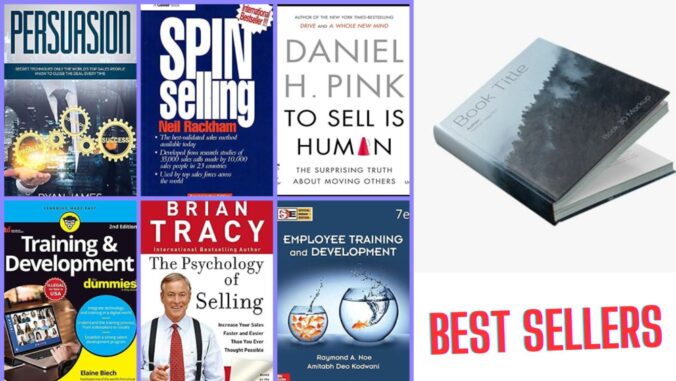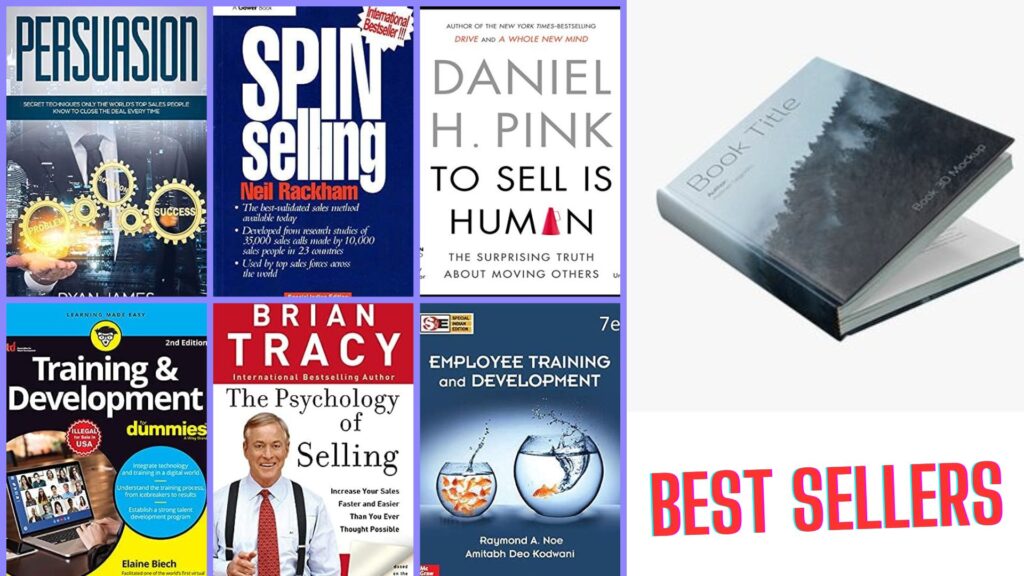
Table of Contents
Here are some books enduring works on salesmanship that have stood the test of time and will probably continue to be important in the future. This book also Holds Names in “THE GUARDIAN“, “LITHUB“, “The Book report Network” and “BookReporter” as having the highest sales Records offline and Online. They are Listed Below :
1. Dale Carnegie’s “How to Win Friends and Influence People” (Salesmanship Books)
Anyone interested in enhancing their interpersonal and salesmanship should read this timeless classic.
It provides helpful guidance on how to form connections, speak clearly, and positively influence people.
For anybody looking to strengthen their interpersonal and communication skills, “How to Win Friends and Influence People,” by Dale Carnegie, is a must-read.
The ideas presented in this book, which was first published in 1936, are still pertinent and relevant today.
Aspects of interpersonal communication and relationship-building are covered in each of Carnegie’s book’s several sections.
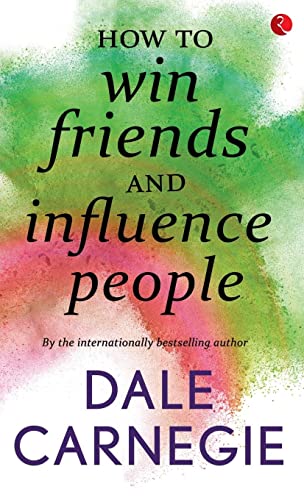
Here is a breakdown of some important conclusions:
- The Fundamentals of Dealing with People
Carnegie highlights the value of genuinely caring about other people.
He advises readers to practice active listening, refrain from criticizing, condemning, or whining, and provide genuine appreciation and praise when appropriate.
These underlying ideas serve as the cornerstones of successful relationship- and communication-building.
2. Six Ways to Make People Like You:
This section provides helpful guidance on how to leave a good impression on other people.
It offers advice on how to smile, remember people’s names, and show genuine interest in them.
These methods can support establishing rapport and trust.
3. How to Win People to Your Way of Thinking
Carnegie explores the psychology of influence and persuasion.
He stresses the significance of avoiding conflicts and instead persuading others to share your viewpoint via compassion and understanding.
This section offers important tips on how to resolve disputes and conflicts diplomatically.
4. Be a Leader- How to Change People Without Giving Offense or Arousing Resentment:
Carnegie talks leadership skills and how to inspire and persuade others to follow your example voluntarily in How to Change People Without Giving Offense or Arousing Resentment.
Effective leaders, according to him, set a good example, acknowledge others, and make others feel valued.
Conclusion
The ideas Dale Carnegie teaches are vividly illustrated in his book by examples and tales from everyday life.
The events he discusses are simple to connect to, which makes the advise more applicable and doable. The book’s enduring relevance is one of its advantages.
Both interpersonal interactions and professional settings may benefit from Carnegie’s teachings.
The ideas in this book may make you a better communicator and influencer whether you’re looking to strengthen your bonds with friends, family, or coworkers.
The terminology and examples in the book may, however, seem a little old to certain readers because it was published in the early 20th century.
The fundamental ideas are still important, though, and readers may apply them to modern circumstances.
The classic self-help book “How to Win Friends and Influence People” gives useful and timeless guidance on successful communication, establishing connections, and influencing others.
Anyone wishing to improve their interpersonal skills and succeed in both their personal and professional life will find it to be a useful resource.
CLICK ON THE LINK TO CHECK THIS BOOK – Dale Carnegie’s “How to Win Friends and Influence People
2. Brian Tracy’s “The Psychology of Selling” (Salesmanship Books)
This book is among Brian Tracy’s most well-known creations. Brian Tracy is a well-known authority in sales.
It explores the psychology of selling, consumer comprehension, and persuasive technique. “The Psychology of Selling” by Brian Tracy is a thorough manual on the principles and practices of effective selling.
Tracy presents insightful explanations of the psychology of selling and delivers doable suggestions for enhancing sales effectiveness, drawing on his broad experience as a sales trainer and consultant.

The following are some salient ideas to remember from the book:
- Understanding the Psychology of Buyers
Tracy highlights the need of comprehending the thinking and motives of potential customers.
He investigates the psychological aspects of buying choices, such as feelings, wants, and desires.
Salespeople may successfully adjust their approach to match clients’ unique requirements by learning about the psychology of consumers.
2. Building Rapport and Trust
Tracy spends a considerable amount of the book discussing how to build trust with customers, which is essential in sales.
He provides strategies for building rapport, displaying empathy, and inspiring confidence in potential clients. Tracy thinks that the basis of effective selling is trust.
3. Effective Communication
Successful selling is based on effective communication. Tracy offers insightful advice on effective communication techniques, including as active listening, asking open-ended questions, and utilizing language that appeals to clients.
He also touches on the significance of body language and nonverbal communication in building rapport.
4. Closing the Sale
The part of the sales process known as close is sometimes seen as the most crucial, and Tracy provides a number of closing methods and strategies.
He stresses the need of being certain and aggressive while simultaneously showing respect for the customer’s choices.
5. Handling Rejection and Overcoming Objections
Tracy offers tips for dealing politely with rejection and objections, which are unavoidable in sales.
He advises salespeople to consider objections as chances rather than barriers to address issues and provide solutions.
6. Goal-setting and time management
Tracy talks about how crucial it is to create specific objectives and manage your time wisely in the sales industry.
He gives helpful guidance on creating SMART goals—specific, measurable, realistic, relevant, and time-bound—as well as time management strategies to increase productivity.
7. Continous Improvement
Tracy is a proponent of continuing education and development. He advises sales personnel to consistently hone their abilities, remain current on market developments, and pursue personal growth in order to succeed in their employment.
Conclusion
Even while “The Psychology of Selling” is filled with useful advice for salespeople, it’s important to note that some readers could find Tracy’s method to be overly formulaic.
The book offers a methodical framework for selling, which may be useful but may not fit everyone’s strategy or selling style.
In conclusion, “The Psychology of Selling” by Brian Tracy is a helpful and educational manual for everyone working in sales.
It covers a wide range of subjects pertaining to persuasive communication, client trust-building, and the psychology of selling.
The ideas and tactics given in the book may surely help sales professionals improve their abilities and get better outcomes in their jobs, even though some readers may find it to be a little predictable.
CLICK ON THE LINK TO CHECK THIS BOOK – Brian Tracy’s “The Psychology of Selling”
3. Daniel H. Pink’s book “To Sell Is Human”(Salesmanship Books)
The Surprising Truth About Moving Others” Pink examines the notion that, whether or not we have a formal title, all of us work in sales in this book.
He offers insights into how selling has changed and offers helpful advice on how to influence people more successfully.
The book “To Sell Is Human” by Daniel H. Pink is a perceptive examination of the art and science of marketing in the twenty-first century.
Pink questions prevalent ideas about selling and contends that, whether they are aware of it or not, practically everyone in today’s world is engaged in selling.
The book gives a novel viewpoint on sales as well as helpful suggestions for convincing and influencing others.
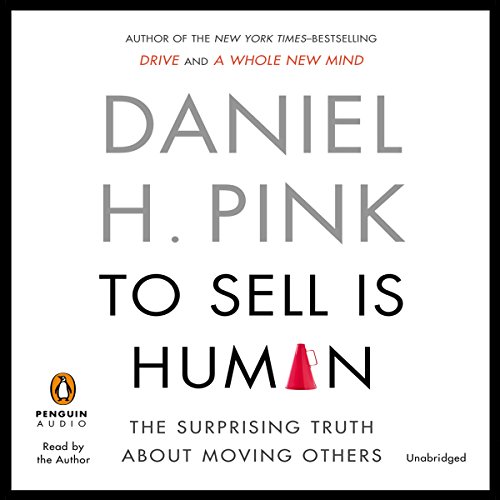
The following are some salient ideas to remember from the book:
1.The New Era of Selling
Pink begins by outlining how sales have changed over time. He contends that selling is no longer the sole purview of salesmen but rather is an essential component of interpersonal communication.
To some extent, selling ideas, things, and ourselves is what we’re all in the business of doing.
2. The ABCs of Selling
Pink provides a new paradigm for selling in which Attunement, Buoyancy, and Clarity take the place of the conventional ABCs (Always Be Closing).
These abilities center on comprehending people, navigating a sea of rejection, and effectively and purposefully communicating.
3. The Importance of Empathy in Selling
Pink stresses the significance of empathy in selling. He examines the idea of attunement, which entails putting oneself in another’s shoes, appreciating their viewpoint, and developing a genuine connection.
The foundation of trust and rapport is empathy.
4. Resilience in the Face of Rejection
Rejection is a given in the world of sales. Pink addresses the idea of buoyancy, which is the capacity to recover from setbacks and have an optimistic outlook.
He provides advice on how to handle rejection well and use it as a teaching opportunity.
5. Pitching with Clarity
Pink explores the principles of persuasive communication. He offers advice on how to create messages and proposals that will captivate an audience.
Clarity, simplicity, and applicability are prioritized.
6. The Effect of Information and openness
Pink investigates how the dynamics of selling have altered as a result of the digital age’s wealth of information and enhanced openness.
He talks on how both buyers and sellers now have greater access to information, which calls for a different strategy for selling.
7. Servant Selling
Pink proposes the idea of “servant selling,” which entails putting the customer’s wants and interests first rather than pushing a particular commodity or service.
This strategy fits with the desires of contemporary customers for value and genuine interaction.
Conclusion
The book “To Sell Is Human” is well-researched and full of real-world examples and stories that help to clarify the ideas raised.
Pink’s language is fascinating and readable, making the book an appealing read for both salespeople and anyone looking to hone their persuasive abilities.
The book’s realization that selling is about more than just closing deals is one of its strongest points. Selling is also about getting to know, relate to, and assist others.
Pink’s novel viewpoint challenges received knowledge in sales and offers a more comprehensive and sympathetic method of selling.
To sum up, Daniel H. Pink’s “To Sell Is Human” is an insightful and worthwhile work that updates the idea of selling for the twenty-first century.
It is a must-read for anybody interested in the art of influence and persuasion since it gives readers useful ideas and tactics for effective persuasion, communication, and relationship-building.
CLICK ON THE LINK TO CHECK THIS BOOK – Daniel H. Pink’s book “To Sell Is Human“
4. Neil Rackham’s “SPIN Selling” (Salesmanship Books)
The SPIN approach, which helps salespeople ask the appropriate questions and thoroughly grasp their clients’ demands, is the main topic of this book.
It is supported by in-depth research and offers helpful insights for B2B selling.
Neil Rackham’s seminal and famous book “SPIN Selling” transformed the sales industry by presenting a methodical strategy for selling based on facts and research.
Situation, Problem, Implication, and Need-Payoff are the four categories of inquiries that competent salespeople should pose to prospects and customers. The abbreviation “SPIN” stands for these four categories.

Here is a summary of the main ideas and lessons from “SPIN Selling”:
1.Situational Questions
According to Rackham, effective sales talks should start with inquiries that elicit details about the prospect’s present condition.
These inquiries assist the salesperson in comprehending the background and particulars of the potential customer’s business, which is essential for customizing the sales approach.
2. Problem Questions
The use of problem questions is at the core of SPIN Selling. These inquiries are aimed at identifying the obstacles and pain points of the possibility.
The salesman might engender a sense of urgency and need for a solution by pointing out difficulties.
3. Implication Questions
Following the identification of the issues, implication questions probe further into the repercussions and ramifications of those issues.
They aid the prospect in realizing the gravity of the situation and any possible drawbacks.
4. Need-Payoff Questions
When a prospect is asked a need-payoff question, the conversation tends to go toward the advantages and benefits that employing the salesperson’s good or service may bring about for them.
These inquiries nudge the prospect to explain the benefit they perceive in the remedy.
Conclusion
Rackham’s method of selling is based on in-depth investigation carried out by his company, Huthwaite, which examined thousands of sales calls from diverse sectors.
Data showed that consultative sales approaches and a large volume of powerful questions, particularly issue and implication inquiries, were characteristics of the most successful salespeople.
The data-driven methodology of “SPIN Selling” is one of its main advantages. The SPIN approach is supported by practical data from Rackham’s study, which elevates it above the level of a purely theoretical idea.
For sales professionals aiming to increase their performance, it provides a clear route.
The SPIN Selling method may, however, demand a substantial change in a salesperson’s attitude, particularly for those used to more conventional sales approaches.
Effective SPIN Selling implementation may need practice and customization.
In conclusion, Neil Rackham’s book “SPIN Selling” is a classic in the world of sales and is praised for its data-driven approach to successful selling methods.
It offers a systematic framework that salespeople may use to hone their probing and problem-solving abilities, which will ultimately result in more fruitful sales conversations.
The book’s concepts and tactics are still useful tools for anybody in the sales industry, even though they might not be a one-size-fits-all answer.
CLICK ON THE LINK TO CHECK THIS BOOK – Neil Rackham’s “SPIN Selling”
5. By Matthew Dixon and Brent Adamson, “The Challenger Sale: Taking Control of the Customer Conversation”(Salesmanship Books)
This book offers a novel method of doing sales, emphasizing “challenger” salespeople who challenge clients’ assumptions and offer novel viewpoints.
It highlights the significance of offering insightful information and developing trusting connections with clients.
The provocative and data-driven investigation of a sales tactic that goes against conventional methods is presented in “The Challenger Sale” by Matthew Dixon and Brent Adamson.
The writers’ in-depth study forms the basis of this book, which also describes a sales technique they refer to as “The Challenger Sale.”
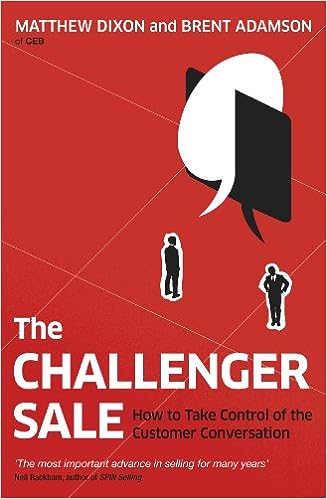
The following is a summary of the main ideas and lessons from “The Challenger Sale”:
1.The five profiles of a salesperson
Dixon and Adamson distinguish five different salesperson profiles:
- Building Relationships
- The Solution Provider
- The Prompt Worker
- The Single Wolf
- A challenger
2. The Challenger Salesperson
According to the writers, Challengers are the most effective salesmen. The capacity to question the customer’s mindset while presenting fresh viewpoints and insights defines challengers.
Customers learn something novel and unexpected from them, resulting in more worthwhile and fruitful dialogues.
3. Teaching & Tailoring
Challengers are excellent at instructing their clients and leading them through the decision-making process by offering insightful and unique ideas.
They customize their communication to meet the individual demands of each client, questioning the status quo and presenting creative answers.
4. Commercial Insight
The use of “commercial insight” is a crucial component of the Challenger Sale. Customers are given facts, trends, and insights that they might not be aware of in this process, and this eventually results in a compelling cause for the consumer to alter something or take action.
5. Rethinking the Sales Process
The book questions the accepted understanding that developing solid connections is the key to a successful sales strategy.
Instead, it promotes questioning consumers’ assumptions in order to have more fruitful sales dialogues and achieve better outcomes.
Conclusion
The data-driven methodology of “The Challenger Sale” is one of its advantages. The authors’ study is based on in-depth polling and examination of thousands of salespeople and their clients. This factual basis gives the Challenger Sales process and its efficacy legitimacy.
It’s crucial to remember that not all sectors or product and service types may be appropriate for the Challenger Sales technique.
Building solid connections may continue to be an important part of the sales process in some situations since some consumers may not respond well to the Challenger approach.
In conclusion, Matthew Dixon and Brent Adamson’s ground-breaking book “The Challenger Sale” questions accepted theories about selling and offers a novel viewpoint on successful sales strategies.
The book provides insightful information on how questioning clients’ thinking and offering commercial insight may result in more fruitful sales interactions and better outcomes, even though the Challenger Sales method may not be a one-size-fits-all answer. It is essential reading for salespeople trying to improve their strategies and results.
CLICK ON THE LINK TO CHECK THIS BOOK – Matthew Dixon and Brent Adamson, “The Challenger Sale: Taking Control of the Customer Conversation”
6. Robert B. Cialdini’s “Influence: The Psychology of Persuasion” (Salesmanship Books)
This book addresses the concepts of persuasion and how they may be utilized responsibly to influence other people’s decisions, even if it is not simply centered on salesmanship.
One’s sales ability can be considerably improved by comprehending these ideas.
In the disciplines of psychology, marketing, and persuasion, “Influence: The Psychology of Persuasion” by Robert B. Cialdini is regarded as a classic. This book is a thorough examination of the psychological theories and methods that affect people’s behavior and decision-making.
Famous psychologist and researcher Cialdini breaks down the art of persuasion into six fundamental principles and offers countless examples from everyday life to show how they might be used.
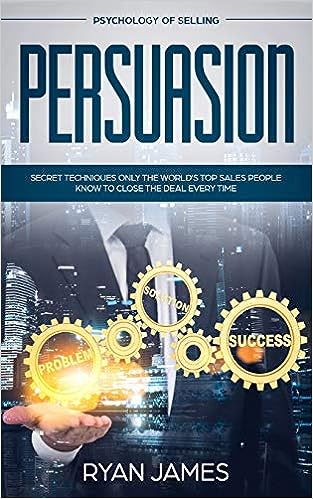
Here is a summary of the six impact principles covered in the book:
1. Reciprocity
Regarding reciprocity, Cialdini notes that when someone does something for them, humans have a strong, instinctive urge to return the favor.
You may instill a feeling of duty in people and increase the possibility that they will comply with your demands by giving before you ask and by providing something of value.
2. Commitment and Consistency
People naturally tend to stick to their prior commitments and behaviors. By starting with smaller, linked commitments, Cialdini explores how this theory might be used to encourage people to perform bigger activities.
3. Social Proof
Cialdini argues how individuals frequently seek to others for guidance on how to act in ambiguous or unsure circumstances. Providing evidence that others have done a specific action can have a big impact on decision-making.
4. Liking
Persuasion is more likely to succeed when people are liked and trusted by the target audience. Cialdini looks at how improving persuasive attempts may be accomplished through developing rapport, discovering common ground, and forging a sincere relationship.
5. Authority
Cialdini highlights the ability of those in positions of authority to influence others. He talks about how people are prone to take the suggestions and counsel of respectable authorities.
6. Scarcity
The scarcity concept calls for emphasizing restricted availability or exclusivity in order to foster a sense of urgency. Cialdini illustrates how people’s actions might be motivated by their fear of losing out.
Conclusion
Because of Cialdini’s engaging and approachable writing style, difficult psychological topics are made intelligible and relevant.
He gives various examples from the real world, ranging from advertising campaigns to sales techniques, to show how these ideas may be used successfully.
The book’s ethical viewpoint on persuasion is one of its advantages. While outlining methods for influencing people, it also calls attention to the unethical ways in which these methods are applied in various situations. Cialdini exhorts readers to make more thoughtful decisions and purchases.
For anybody interested in learning about the psychology of persuasion and how it affects our daily lives, “Influence: The Psychology of Persuasion” is a valuable resource.
It’s helpful for everyone who wants to be a better educated and critical thinker in a world full with persuasive messages, not just sales and marketing experts.
This book continues to be a cornerstone in the research on persuasion and human behavior because of the long-lasting influence that Robert B. Cialdini’s work has had.
Other Related Topics
- Sales Presentation
- Sales Forecasting
- Sales Quota
- Sales Management
- Sales Territories
- Salesman – Types & Functions
- Buying Motives – Types & Stages
- Market Research
- What is Salesmanship? – Full Concept
- To Sell Is Human: Review & Summary – Quick Read
- The Psychology of Selling – Quick Read
- Book Insights & Review: “How to Win Friends and Influence People”
- World Most Selling Salesmanship Books| You Must Buy
- The Most Essential Knowledge for a Salesman
- Personal Selling: Full Concept In Detail
- The Essential Qualities & Skills for a Successful Salesman
